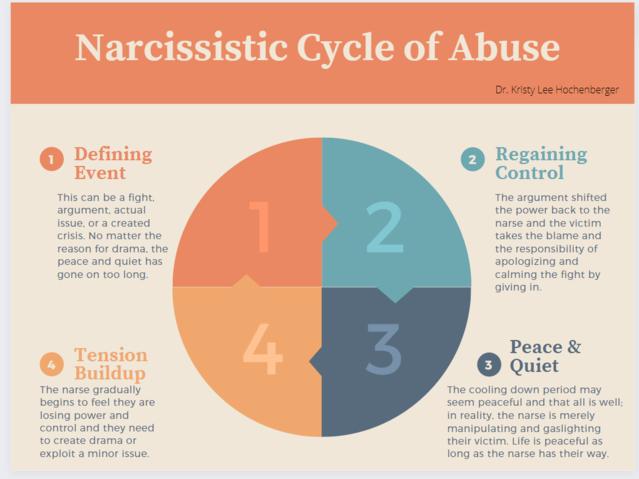Narcissism
The Narcissistic Cycle of Abuse
The cycle of abuse theory can be applied to narcissists' abusive relationships.
Posted March 28, 2022 Reviewed by Ekua Hagan
Key points
- The 1979 cycle of abuse theory can be adapted to fit relationships in which one partner is high in narcissism.
- Covert narcissists and female narcissists may be more likely to utilize a cycle of abuse in order to stay in control.
- Learned helplessness is a major reason why victims stay in abusive relationships.
The cycle of abuse is a theory conceptualized in 1979 by Lenore Walker that identifies continual, repeated events in an abusive relationship. It was originally established as a means of contextualizing violent incidents against women in romantic relationships (Serrata, 2017).
The cycle of abuse includes four stages, or steps (Bottaro, 2022):
- Tension
- Incident
- Reconciliation/Honeymoon
- Calm
The cycle of abuse coincides with intimate partner violence (IPV). Since its conception, researchers have adapted the original cycle of abuse theory to expand to all genders, ages, relationships, and forms of abuse.
A relationship does not need to be physically violent to be considered abusive or harmful. Emotional, spiritual, and psychological abuse can be just as damaging to the human psyche as physical abuse.
IPV has been linked to narcissistic relationships in the facets of emotional and psychological abuse as well as physical abuse. Additionally, research has found that covert narcissists and female narcissists are more likely to utilize a cycle of abuse in order to stay in control.
Manipulation, Control, and Relationships
Individuals with narcissistic personality disorder and those with strong narcissistic tendencies can be very manipulating and controlling individuals. Keep in mind that it is possible to have narcissistic traits and not have diagnosable narcissistic personality disorder, which is a clinically rare occurrence.
When it comes to any type of relationship requiring honesty, transparency, and genuine emotion, highly narcissistic individuals are often unable to keep up the charade for very long. This exhaustion of pretending to be an equal partner is what typically precedes the narcissistic cycle of abuse.

In many cases, relationships are meant to serve the purpose of pleasing the narcissistic individual, keeping them in the entitled role they believe they deserve with the admiration and perks that go along with the role. They may believe they are never responsible for things going wrong and may struggle or seem entirely unable to empathize with another person’s pain unless that pain is affecting them directly. Narcissists tend to have a fragile ego that is reliant on external influences; the more they have—or the more they are perceived to have—equates to their self-worth.
Highly narcissistic individuals may seem to have a picture-perfect life: a big house, happy family portraits, a shiny new car, enviable vacations. Beyond those external trappings, however, may be a quiet, hidden pattern of emotional abuse that never stops cycling. A constant push-and-pull dynamic can eventually cause the victim to develop learned helplessness in which they feel trapped and unable to leave the relationship. Some studies have shown that vulnerable narcissists—who are hyper-sensitive to rejection and crave social validation—may be more prone to utilizing the cycle of emotional abuse rather than physical abuse or coercion (Green et al., 2019).
The Narcissistic Cycle of Abuse
The original cycle of abuse’s four steps can be adapted to fit narcissistic relationships. Just as physical violence is not only perpetrated by one gender, narcissistic abuse is unisex. Instead of using fists or smashing bottles to hurt someone, someone high in narcissism tends to use gossip and lies to mar the victim's reputation. This person may use whatever means necessary to keep their partner in line and themselves in control of the narrative. Even if they are called out on their lies and smear campaign, the narcissist may state that the victim deserved it.
The narcissistic cycle of abuse (Fig.1) illustrates the four parts of the cycle. It is important to understand that there is no “first” or “last” step of the cycle, as it is a continuous pattern with no clear beginning or end. Rather, the narcissistic cycle of abuse is how narcissistic individuals exploit their partners into doing what they demand and force them to ebb and flow according to the narcissist’s whims.

The four stages of the narcissistic cycle of abuse are based on Walker’s stages. Like Walker’s cycle of abuse, the narcissistic cycle can begin or end at any stage and continue on.
Stage 1: Defining Event. The “defining event” is not so much the crisis, but instead often refers to an outburst on the part of the narcissist. This may be an actual fight, argument, or even just a simple miscommunication. The crisis can be real or imagined. No matter what the reason is for the drama—even a minuscule inconvenience—in this scenario, the narcissist finds a reason to explode. The narcissist may have started to feel as if they were losing control of a situation or a person and thus has to cause an issue to bring attention back to themselves.
Stage 2: Regaining Control. Even if the person high in narcissism is to blame for the crisis or problem, it may be that the victim ends up being apologetic. The "Defining Event" often shifts the power back to the narcissist and places the blame squarely on the victim. The victim may end up apologizing due to either learned helplessness or simply to keep the peace.
Learned helplessness can be a major reason behind the continuation of the cycle of narcissistic abuse. The partners of narcissists often confuse fear with love and thus may do anything to keep the peace. Fear, abuse, intimidation, and exploitation are not love and should never be confused with affection.
Stage 3: Peace and Quiet. The cooling-down period may seem peaceful on the outside. But on the inside, the victim may be constantly scrambling to “make it up” to the narcissist. The narcissist may further manipulate the situation to reflect positively on them and negatively on the victim. Gaslighting is also extremely common during this period, and the narcissist may construct an entirely new narrative about the problem. Life is peaceful as long as the narcissist has their way and is the center of attention.

Stage 4: Tension Buildup. Over time, the narcissist will begin to lose control of a narrative, another person, or a situation. Life has been continuing quietly and normally, but even the victim begins to get uncomfortable with the peace. Tension starts to build out of the victim’s fear of the narcissist and the narcissist’s fear of losing control. It’s only a matter of time before the narcissist explodes by creating drama and exploiting a minor issue; then begins another cycle of the push-pull relationship dynamic and imbalance of power.
Healthy vs. Toxic Relationships
All relationships go through natural cycles of peace and conflict. It is inevitable that a couple will have to face major life disasters beyond their control as well as interpersonal crises.
However, the difference between normal and abuse cycles is the level of respect for each other and the balance of power. It is entirely possible to face a crisis together and not destroy each other in the process of rebuilding and healing. Another difference between normal cycles of relationships and abusive cycles is actually solving the problem and working together to avoid pitfalls in the future.

Getting Help
If you are stuck in a cycle of abuse, help is available. Contact the National Domestic Violence Hotline at victimconnect.org or thehotline.org.
To find a therapist, please visit the Psychology Today Therapy Directory.
References
Bottaro, A. (2022). Cycle of abuse. Very Well Health. Cycle of Abuse: Definition, Four Stages, Healing (verywellhealth.com)
Green, A., Charles, K., and MacLean, R. (2019) Perceptions of Female Narcissism in Intimate Partner Violence: A Thematic Analysis. Qualitative Methods in Psychology Bulletin, 13-27.
perceptions-of-female-narcissism-in-intimate-partner-violence-a-thematic-analysis.pdf (napier.ac.uk)
Serrata, J. (2017). The SAGE encyclopedia of psychology and gender. "Cycle of abuse". https://dx.doi.org/10.4135/9781483384269




